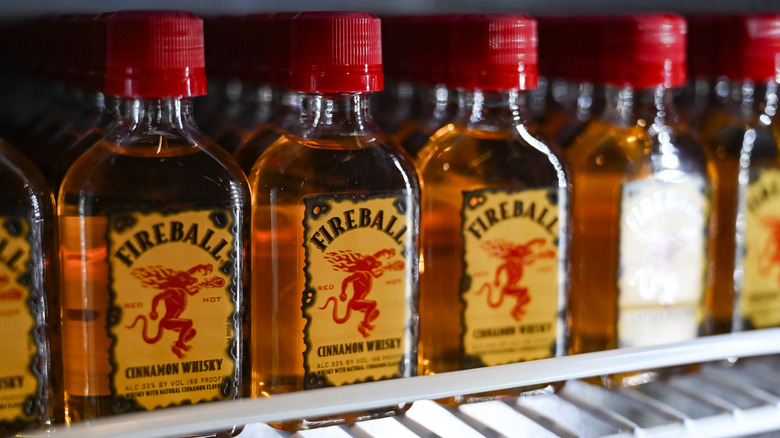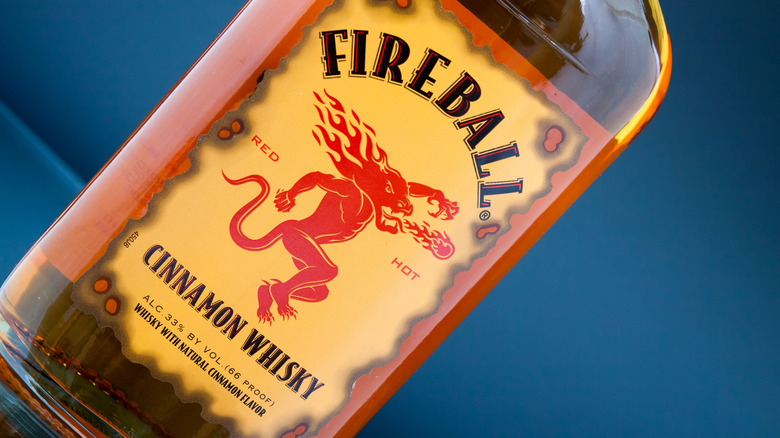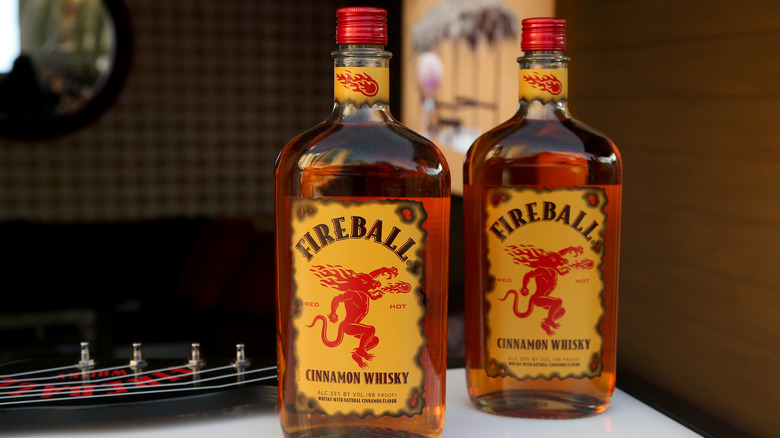Why Fireball Doesn't Quite Count As Whiskey
Love it or hate it, Fireball Cinnamon Whisky has undeniably carved out its own space in dive bars and college parties. The sweet and cinnamon-scented spice makes it a pretty forgiving drink despite the fiery name — even those who aren't big into alcohol can usually knock one back pretty easily. But despite its label, Fireball's association with genuine whisky is, at best, a stretch.
The issue isn't just that Fireball is mostly seen as a cheap drink and not a fine spirit that most people would associate with the term "whisky." The real issue is that technically speaking, it doesn't meet the requirements to be called whisky at all! Whisky-producing countries like Scotland, Ireland, and the U.S. all enforce strict regulations defining what qualifies as the drink — you can't age some random liquor in a cask for a few years and call it a whisky right away. These regulations may differ across borders, but they generally share a common requirement: A minimum alcohol content. Most countries mandate that a spirit must have an alcohol by volume (ABV) of at least 40% to be considered whisky. It's here that Fireball Cinnamon Whisky encounters its stumbling block.
Fireball simply lacks the heat
Fireball is a Canadian brand, so it's subjected to Canadian laws on how it can name its drink. Per Canadian Food and Drug Regulations, to be considered a Canadian whisky, besides being made in Canada, it must also "contain not less than 40 percent alcohol by volume." While Fireball does contain Canadian whisky (which is why they can call it whisky in the first place), Fireball is "down-proofed" and includes the addition of sweeteners and cinnamon spice — it's a flavored whisky. As a result, it falls short of traditional whisky by having an ABV of just 33%, or 66 proof. This puts it in a grey area — it's technically not whisky but falls into the liqueur category.
But Fireball isn't the only one playing this semantic game. Malibu, the coconut liquor prominently featured in many tropical cocktails like the Malibu Barbie, is often called "coconut rum" because it includes Caribbean rum and flavorings. Yet, it doesn't quite meet the requirements to be called rum, either. The difference lies in consumer perception. While Malibu is mostly viewed by customers as a distinct product from regular rum, Fireball is often mistaken for traditional whisky, especially because of its labeling. This confusion has caused plenty of legal headaches over the years for Sazerac, the company that produces Fireball.
Fireball Cinnamon versus Fireball Cinnamon Whisky
Today, there are two types of Fireball drinks available: Fireball Cinnamon and Fireball Cinnamon Whisky. The term "whisky" is key here. The non-whisky Fireball is a malt-based beverage with added flavor to imitate whisky, containing no actual whisky whatsoever. It has a lower ABV of about 16.5% and is often displayed alongside low-proof drinks like beers and wines. On the other hand, Fireball Cinnamon Whisky is what most people think of when they hear "Fireball."
Confused? Lots of people were, too, and Sazerac was hit by a class-action lawsuit for this exact reason. The lawsuit criticized the company for using the phrase "With Natural Whisky & Other Flavors" on the Fireball Cinnamon label, which caused people to interpret it as having actual whisky rather than whisky flavoring (though even Fireball Cinnamon Whisky isn't a true whisky anyhow).
In essence, there's currently no Fireball-branded liquor available that can be called a true whiskey. Neither Fireball Cinnamon Whisky nor Fireball Cinnamon can claim that title, with the latter being even less deserving of the label.


